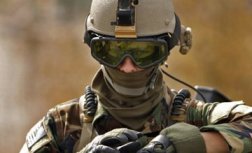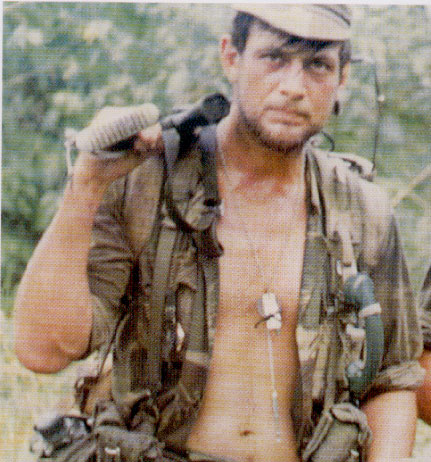|
| Selous Scouts
PSEUDO OPERATIONS
By T. A. Lettieri
What are pseudo operations? Simply in a military scenario it is to perpetrate or pretend to be someone or something you are not, to sham or fake out an opponent in thinking you are one of there own in order to attain a decisive tactical advantage or surprise over the opponent you our impersonating.Pseudo operations are not new. It is standard operation for most law enforcement agencies the world over, in police jargon it is known as a ‘sting’ operation. Pseudo techniques were used successfully by MAC-V-SOG in Vietnam, The British SAS in Malaya, and by the Rhodesians to name but a few. During Rhodesia’s war against insurgents, military authorities within the Rhodesian Security Forces realized the need for accurate ground truth in a time sensitive nature. With that in mind a secret unit was devised to acquire this information. The unit was the Selous Scouts, comprised of intelligence experts from the police and military, soldiers, and turned terrorist / guerrillas. Eventually this small unit of scout trackers turned pseudo terrorists expanded to a formidable counter-insurgency force of close to 1000 operators.They used stealth, guile and subterfuge during active ground reconnaissance to obtain current intelligence and ground truth on terrorist infiltration and exfiltration routes, feeding and staging areas, arms caches, base camps, and support networks. Within the Scouts members were fluent in the native languages of Rhodesia (Shona being the most common native tongue) and understood the people, costumes and culture. The use of the turned or captured terrorist / guerrilla was the final touch giving the pseudo team its credibility to look, act, and operate as a terrorist cell, with the information gleaned from the turned terrorist. These pseudo teams then infiltrated the insurgency infraction with such success that so much information began filtering through the intelligence system that special operation were planned with this information to counter the growing insurgency threat to the state. Which made way for the Scouts to conduct some of its own independent direct action missions.The conduct of pseudo operations by the Selous Scouts proved so successful that by the end of the war in 1980 they were accredited with 70% of all terrorist killed or captured. ISIS - COMBATING IT
The first attempt in Rhodesia to evaluate the pseudo concept as a weapon against terrorism took place in October 1966. The Selous Scouts was a special forces regiment of theRhodesian Army, that operated from 1973 until the reconstitution of the country as Zimbabwe in 1980. Named after the British explorer Frederick Courteney Selous(1851–1917), its motto was pamwe chete—a Shonaphrase roughly meaning "all together", "together only" or "forward together". The charter of the Selous Scouts directed them to "the clandestine elimination of terrorists/terrorism both within and without the country.
Contents
External links· Rhodesian and South African Military History · Rhodesian Special Forces – Roll of honour, awards and images.
Resurrecting the Selous Scouts to Destroy ISIS Special thanks to Patrick Collins for writing this guest post. -Jack
This is not a comprehensive study of counterinsurgency doctrine, rather it focuses on the kinetic tactics that could be employed to eliminate enemy forces (a minor element in broader COIN strategy). The list of differences between the Rhodesian Bushwar and the Global War on Terror is extensive (see below) but the most critical similarity remains: the enemy has/had the power to reach across national borders and the “deep pockets” to procure weaponry, support and provide governance. The strategy of the Selous Scouts was to conduct “pseudo-operations” (false flag) by pretending to be guerillas themselves and luring the true guerillas into ambushes or to gather intelligence about guerilla operations/tradecraft. The Selous Scouts would also attempt to turn captured guerillas making them “tamed terrs” and incorporating them into the unit.
Purpose: ISIS’ “Two Front War” The most daunting task in the past half-century of counterinsurgency warfare has been determining friends and foe. Whether Viet Cong or al-Qaeda inspired militants, counterinsurgents have faced the insurmountable task of discerning civilian from combatant. The resulting psychological pressure of “not knowing” has caused even the most disciplined units to become worn out. While most small unit SOF forces employed guerilla tactics to “terrorize” insurgents, very few have gone to the lengths that the Selous Scouts took to deceive and surprise the enemy. This paradigm shift exposed bushwar insurgents to the psychological pressures normally experienced by counterinsurgents: the constant fear of deception, betrayal and surprise attacks. Scouts would often stage elaborate scenarios where black members of the unit would pretend to be guerillas leading captured white soldiers into a guerilla camp. At the last moment all weaponry would be returned to the pseudo-captives, allowing the Scouts to catch the entire camp by surprise. Even though the sides of the conflict seemed as stark as “black and white”, the Scouts knew how to use their craft to show guerillas that they were not safe. In examining the current struggle against ISIS in Iraq and Syria, the model of pseudo-operations could readily be applied to wield a kinetic as well as psychological blow to ISIS and to fill gaps in intelligence collection. ISIS’ ability to function as a pseudo-government that controls territory and as a pseudo-military that blends both conventional and asymmetric tactics makes it the ideal target for exploitation by a pseudo-operations group. To many, the ability of ISIS to straddle the world of conventional and non-conventional the group’s greatest strength since it can provide “legitimate” governance as well as armored military might augmented by guerilla/terrorist tactics. This “strength” is in fact their greatest vulnerability since they are susceptible to the same weaknesses that plague governments and militants alike. Psuedo-operators would force ISIS into a two-front war, much like the Selous Scouts threatened both insurgent governments and guerillas alike. ISIS has relied on both terrorist theatrics (beheadings, ransoms, televised threats) as well as military prowess that incorporates some conventional tactics and command structure. As a guerilla force, Scouts could target ISIS’ governmental structure and create an insurgency with bombings, kidnappings and assassinations of ISIS leaders. An attempt to crush the Scouts using conventional force such as tanks, artillery and irregular infantry would be thwarted by additional guerilla attacks by the Scouts designed to target conventional(ish) vulnerabilities. Since ISIS also maintains its image as a terrorist/insurgent group, Scouts could perform pseudo-operations to infiltrate and decimate ISIS from within. Likewise, scouts could stage false flag operations to lure ISIS elements into the open to be dispatched by air power or conventional units. All three approaches would work to turn the insurgency against the “insurgents” both kinetically and psychologically.
*note “blue” represents Scout forces while “Black” represent ISIS forces/government Formation: Forging the new unconventional The formation of such a group would require collaboration across all branches of the US Military as well as SOCOM and the Intelligence Community. Since the original Selous Scouts grew up in Rhodesia, knew the bush that they fought in, and were at least somewhat familiar with the culture and history of their enemies, an emphasis would need to be placed on cultural knowledge (languages, customs, history, etc.) for American volunteers to the Scouts. The volunteer would also require extensive warfighting skills with a particular focus on unconventional warfare; although this knowledge could be taught in later training. Though most SOF elements have unconventional warfare capabilities, the Scouts would operate in truly unconventional, guerilla circumstances. With minimal reliance on US military technology, resupply, firepower and equipment, the teams would function with strict oversight but little structure. Selection and training for the group would mirror the curriculum of the Selous Scouts by first shrinking the applicant pool through rigorous PT, ruck marching, starvation and mind-games (incorporating all relevant evolutions from current US-SOF schools). Once the class was reduced to around 10-20%, the remainder of the course would be focused on learning unconventional warfare and tradecraft related to pseudo-operations. Since applicants would come from all branches and even civilian life/academia, graduates would next be sent to various schools to round out their skillsets (language school, sniper school, demolitions, ect.) Once downrange, team members would recreate the course to incorporate indigenous personnel as well as captured insurgents to be turned into “tamed terrs” (to use the Rhodesian phrase). The Rhodesian Selous Scouts had extensive knowledge of the bush that they grew up in and the rebels they fought against but they had to rely on makeup and extensive “costuming” to play the part of a Marxist guerilla and convince hapless terrorists of the authenticity. While this masquerade of appearance and cultural practices would continue to be a critical weapon in the Scout’s arsenal, the use of social media and technology would serve as a relatively safe way to initiate and guide pseudo-operations. Scouts would undergo training to create fake accounts to spread “propaganda”, disseminate videos and boost their militant credentials. These activities would not replace fieldwork/raids but would complement their intelligence collection, potentially helping them pinpoint locations of other cyber-jihadists nearby. Deployment After developing a cadre of indigenous personnel to incorporate into the Scouts, the teams would begin work on a specific strategy. Some would focus on conducting pseudo-missions against ISIS while others would conduct guerilla operations against ISIS to build bona-fides with other terrorist groups (hostile to the US) and in turn conduct pseudo-operations against them. In a war where there are multiple enemy sides, the Scouts would be able to strike at any terrorist group hostile to US interests. While this would potentially create chaos or a power vacuum, it would be highly effective for gathering intelligence and destroying terrorist infrastructure. This model is not intended to bring stability and order to Mesopotamia and the Levant. Rather, it comprises the 10% of counterinsurgency doctrine that requires kinetic force against the enemy. It would serve as an effective method to identify insurgent infrastructure, terrorist plots/networks and build intelligence collection capacity. Byshifting the insurgency paradigm against the pseudo-government of ISIS, Scouts would psychologically degrade the will of the organization and its fighters. Although operators would be compensated for their service, the independent structure and ethos of the Scouts would come with the understanding that their specialized training and mission would mean forgoing the military “comforts” of tremendous firepower and specialized equipment. This minimalist approach to combat support would drastically increase the “tooth-to-tail” ratio of the unit.
| ||||||||||||||||||||||||||||||||||||||||||||||||||||||||||||||||||||
| About |  | Course |  | CFET |  | Humint |  | DBASE |  | ATP |  | Contact |  | bn-int-sec ic |





.jpg)





